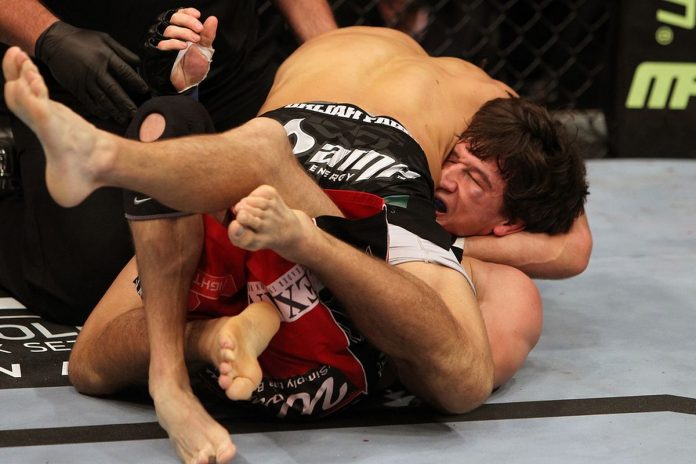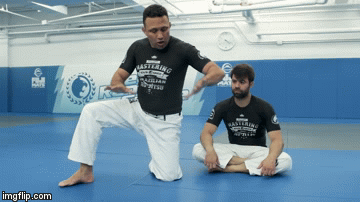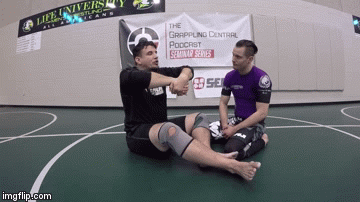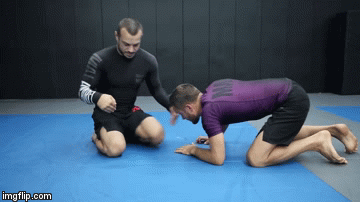
Guillotine chokes are not just another submission in Brazilian Jiu-Jitsu. Across all grappling martial arts, guillotine chokes have a role to play. Very often, they’re among the highest percentage submissions people have at their disposal. In modern days, the guillotine is having somewhat of a revival. Not that guillotine chokes ere ever gone, but nowadays, they seem to be everywhere. This, inevitably, leads to experimentation and the creation of different new variations. The one defining factor of a guillotine’s effectiveness is in one tiny crucial detail – the grips.
The reason people going for guillotine chokes is their versatility. Unlike many other BJJ submissions, guillotine chokes literally work from everywhere. Successful guillotine setups are available from the guard, from the mount, from both top and bottom half guard, from standing. The list goes on and on. Even better, guillotine mechanics are fairly simple, with just a few key details to focus on.
AS far as variations of the choke itself go, people usually recognize a couple of main ones. Those are the arm-in guillotine and the classic guillotine. these two are the base from which all other guillotine chokes stem, regardless of positioning. Both these variations, though, require different grips to truly work at a high level.
Finishing Guillotine Chokes
Without getting into the specifics of guillotine chokes we’ll only go over some key finishing details. the first is the position you’re doing a guillotine from. Usually, it is the guard, but it can also be any of several top positions. Wherever you are, you need to remember that your hips need to be over the opponent’s hips.
The next key thing is head position. The head of your opponent has to remain bent forward at all times. This holds for any position. Usually, it is your armpit or your chest that helps you put pressure on the back of the head. What prevents the opponent from extracting their head is the almighty chin strap This is when you cradle their chin in the palm of one hand.
Also very important, you need to have control over the posture. From top positions, this is not hard, as the floor is a great aid. From bottom positions, though, you’ll need to have a leg over the opponent’s back. When you do this, make sure you keep it as high towards their head as possible. Remember to also have your toes pointing forward, like a ballerina’s foot.
The final tip is to avoid going for a squeeze and a pull when finishing guillotine chokes. The key is to compress the space where their head is, not extend it. In order to achieve this, you need to look to touch the elbow of the arm that you have around their neck to your knee on the same side.
Guillotine Grip Variations
All that covered, it’s time to focus more attention on how you grip your hands. The first thing we need to clear up is that all the high percentage grips do not require any particular athletic capabilities. No need for crazy flexibility or insane amounts of strength. what you actually achieve with the grips are different angles and very precise pressure. Plus, you make sure the opponent can’t escape your grasp.
There’s something beautiful about grips that work just as well in both Gi and No-Gi Jiu-Jitsu. Guillotine chokes work is more often associated with No-Gi, but they can work with the Gi as well. It is all in the grips. The only thing you need to know is when to use grips that work better in an Arm In Guillotine, opposed to a regular one. As you’ll see later on, this is not hard at all.
The BJJ guru of modern times, John Danaher has everything you need to know about guillotines. All his information is neatly packed into about 10 hours of incredible instructions. All of these guillotine chokes and grip variations and many more are in the “Enter The System: Front Headlocks” DVD instructional by the one and only John Danaher.
Ball-In-Socket Grip
The ball and socket grip is the most basic guillotine chokes grip. It is the one people used to use for both the arm-in and regular guillotine. While it still is a good option for both, there have been certain changes that make it way more effective now.

Finishing guillotine chokes with this grip requires you to keep the choking arm high on your chest at all times. Apart from that, finishing mechanics are the same. You need the leg over, an arm in, and you need to crunch to the side before you add squeezing.
Pretzel Grip
The pretzel grip is one of those innovations that completely change a submission. Namely, it is a “hack” for the arm-in guillotine that is simply impossible to escape from. As far as drawbacks go, there’s only one – you can’t use it with a regular guillotine.

While this grip might seem uncomfortable and strange at the beginning it is a great one for guillotine chokes. It allows you to keep the choke ultra-tight. It also allows you to squeeze with your back instead of your arms, making it a much more powerful submission. All basic finishing mechanics still apply.
10 Finger Grip
The 10 finger grip is not really a tight grip when you first think about it. However, if you place your arm precisely, it is a perfect grip for finishing a no-arm guillotine. Just like with the “pretzel” grip, the only drawback is it only works with one variation. This time though, it is the classic guillotine variation.

High Elbow Guillotine Grip
the high elbow guillotine is arguably the most famous of all guillotine chokes, at least at present. The trouble with it is, only a handful of people can actually do it right. And it is all down to how you grip your hands.

having the elbow in such a position might be easy for yogis, but normal people will struggle. To avoid flexibility as a requirement, remember to place your head towards the opposite side shoulder. This will get your arm straight into position. It is so powerful that you’ll rarely even need to squeeze.
DVD and DIGITAL Instructionals Related to Guillotine Chokes :
- MASTERING THE GUILLOTINE BY JOSEPH CAPIZZI
- MASTERING THE GUILLOTINE VOL 2 BY JOSEPH CAPIZZI
-
Mastering Guillotine Concepts and Principles by Karel “Silver Fox” Pravec


![Darce Choke Encyclopedia – Origins, Mechanics and Variations [2025] BJJ, choke, Brabo, BJJ Darce Choke, D'arce Choke, Darce BJJ Choke](https://bjj-world.com/wp-content/uploads/2017/11/JungPoirierLeeYahoo-218x150.jpg)









![Countering with Crab Ride Anthony Budion DVD Review [2025] Countering with Crab Ride Anthony Budion DVD Review](https://bjj-world.com/wp-content/uploads/2025/03/countering-with-crab-ride-anthony-budion-dvd-review-218x150.png)
![Closet Closed Guard Craig Jones DVD Review [2025] Closet Closed Guard Craig Jones DVD Review](https://bjj-world.com/wp-content/uploads/2025/03/closet-closed-guard-craig-jones-dvd-review-218x150.png)
![Xanadu Back Takes Levi Jones-Leary DVD Review [2025] Xanadu Back Takes Levi Jones-Leary DVD Review](https://bjj-world.com/wp-content/uploads/2025/03/xanadu-back-takes-levi-jones-leary-dvd-review-218x150.png)

![No-Gi Grapplers Guide To Front Headlock Joel Bane DVD Review [2025] No-Gi Grapplers Guide To Front Headlock Joel Bane DVD Review](https://bjj-world.com/wp-content/uploads/2025/03/no-gi-front-headlock-joel-bane-dvd-review-218x150.png)



![Welcome To The Darce Side Travis Moore DVD Review [2025] Welcome To The Darce Side Travis Moore DVD Review](https://bjj-world.com/wp-content/uploads/2025/01/welcome-to-the-darce-side-travis-moore-dvd-review-100x70.png)


![Slay The Wrestle Up Guard Nick Rodriguez DVD Review [2024] Slay The Wrestle Up Guard Nick Rodriguez DVD Review](https://bjj-world.com/wp-content/uploads/2024/12/slay-the-wrestle-up-guard-nick-rodriguez-dvd-review-100x70.png)
![Master Scissor Sweep Ryan Scialoia DVD Review [2025] Master Scissor Sweep Ryan Scialoia DVD Review](https://bjj-world.com/wp-content/uploads/2024/12/scissor-sweep-ryan-scialoia-dvd-review-100x70.png)
![Closet Closed Guard Craig Jones DVD Review [2025] Closet Closed Guard Craig Jones DVD Review](https://bjj-world.com/wp-content/uploads/2025/03/closet-closed-guard-craig-jones-dvd-review-100x70.png)
![360 Degrees Guard Retention Thiago Abud DVD Review [2024] 360 Degrees Guard Retention Thiago Abud DVD Review](https://bjj-world.com/wp-content/uploads/2024/10/360-degrees-guard-retention-thiago-abud-dvd-review-100x70.png)
![The Rack Kyle Watson BJJ DVD Review [2025] The Rack Kyle Watson BJJ DVD Review](https://bjj-world.com/wp-content/uploads/2024/12/the-rack-kyle-watson-bjj-dvd-review-100x70.png)

![Advantage Over Time Outside Passing Jozef Chen DVD Review [2025] Advantage Over Time Outside Passing Jozef Chen DVD Review](https://bjj-world.com/wp-content/uploads/2025/03/outside-passing-jozef-chen-dvd-review-100x70.png)

![Jett Thompson Master Ankle and Aoki Lock DVD Review [2024] Jett Thompson Master Ankle and Aoki Lock DVD Review](https://bjj-world.com/wp-content/uploads/2024/09/jett-thompson-master-ankle-and-aoki-lock-dvd-review-100x70.png)
![Two Sides One Game Sweep and Pass Marcos Tinoco DVD Review [2024] Two Sides One Game Sweep and Pass Marcos Tinoco DVD Review](https://bjj-world.com/wp-content/uploads/2024/11/sweep-and-pass-marcos-tinoco-dvd-review-100x70.png)

![Efficiently Executing X-Guard Giancarlo Bodoni DVD Review [2024] Efficiently Executing X-Guard Giancarlo Bodoni DVD Review](https://bjj-world.com/wp-content/uploads/2024/09/efficiently-executing-x-guard-giancarlo-bodoni-dvd-REVIEW-100x70.png)
![Heavy Top Game Fabiano Scherner BJJ DVD Review [2025] Heavy Top Game Fabiano Scherner BJJ DVD Review](https://bjj-world.com/wp-content/uploads/2025/01/heavy-top-game-fabiano-scherner-bjj-dvd-review-100x70.png)



![Full Guard Formula James Booth DVD Review [2025] Full Guard Formula James Booth DVD Review](https://bjj-world.com/wp-content/uploads/2025/02/full-guard-formula-james-booth-dvd-review-100x70.png)



![The Whole Omoplata Enchilada Lyanne Perez DVD Review [2024] The Whole Omoplata Enchilada Lyanne Perez DVD Review](https://bjj-world.com/wp-content/uploads/2024/11/whole-omoplata-enchilada-lyanne-perez-dvd-review-100x70.png)
![Master The Move Anaconda Strangle John Danaher DVD Review [2025] Master The Move Anaconda Strangle John Danaher DVD Review](https://bjj-world.com/wp-content/uploads/2025/02/anaconda-strangle-john-danaher-dvd-review-100x70.png)
![Creating Back Exposure Luke Griffith DVD Review [2025] Creating Back Exposure Luke Griffith DVD Review](https://bjj-world.com/wp-content/uploads/2025/01/creating-back-exposure-luke-griffith-dvd-review-100x70.png)